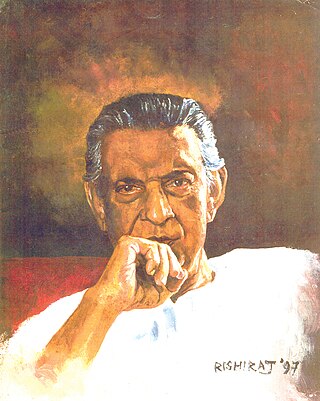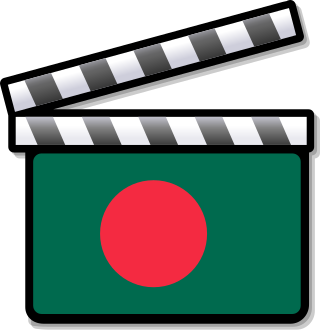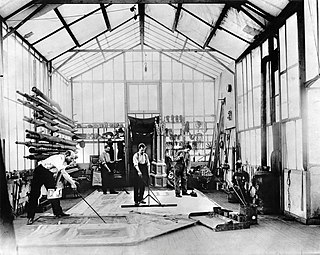
Jaya Bachchan is an Indian actress and politician. She is serving as member of the parliament in the Rajya Sabha from the Samajwadi Party since 2004. Having worked in Hindi films and Bengali films, she is noted for reinforcing a natural style of acting in both mainstream and arthouse cinema. A recipient of several accolades, she has won Filmfare Awards and the Padma Shri, the fourth-highest civilian honour awarded by the Government of India.

SoumitraChatterjee was an Indian film actor, play-director, playwright, writer, thespian and poet. He is regarded as one of the greatest and most influential actors in the history of Indian cinema. He is best known for his collaborations with director Satyajit Ray, with whom he worked in fourteen films.

Shakti Samanta was an Indian film director and producer, who founded Shakti Films in 1957, which is most known for films such as Anand Ashram (1977), Anusandhan /Barsaat Ki Ek Raat (1981), Anyay Abhichar (1985), Howrah Bridge (1958), Insan Jaag Utha (1959), China Town (1962), Kashmir Ki Kali (1964), An Evening in Paris (1967), Aradhana (1969), Kati Patang (1971), and Amar Prem (1972), Amanush (1975).
Asami Jō, also spelled Asami Joh, is a Japanese actress and former AV Idol from Tokyo. Fans of tokusatsu TV shows also know her as the villain Shibolena in the Super Sentai series Denji Sentai Megaranger.

Satyajit Ray was an Indian filmmaker who worked prominently in Bengali cinema and who has often been regarded as one of the greatest and most influential directors in the History of cinema. Ray was born in Calcutta to a Bengali family and started his career as a junior visualiser. His meeting with French film director Jean Renoir, who had come to Calcutta in 1949 to shoot his film The River (1951), and his 1950 visit to London, where he saw Vittorio De Sica's Ladri di biciclette (1948), inspired Ray to become a film-maker. Ray made his directorial debut in 1955 with Pather Panchali and directed 36 films, comprising 29 feature films, five documentaries, and two short films.

The Cinema of Bangladesh, also known as Bangla cinema, is a diverse and vibrant entity, consisting of films produced across various regions in Bangladesh, each contributing its unique linguistic and cultural perspective. Beyond the dominant Dhaka based Bengali-language film industry Dhallywood, which is a portmanteau of "Dhaka" and "Hollywood", Bangladesh is home to cinema in several other languages and dialects. For instance, Chakma cinema from Bandarban, Garo cinema from Sherpur, Meitei and Sylheti cinema from Sylhet, Chatgaiya cinema from Chattogram. These regional cinemas play a crucial role in preserving and promoting the linguistic and cultural heritage of the country. The dominant style of Bangladeshi cinema is melodramatic cinema, which developed from 1947 to 1990 and characterizes most films to this day. Cinema was introduced in Bangladesh in 1898 by the Bradford Bioscope Company, credited to have arranged the first film release in Bangladesh. Between 1913 and 1914, the first production company, Picture House, was opened. A 1928 short silent film titled Sukumari was the first Bengali-produced film in the region. The first full-length film, The Last Kiss, was released in 1931.
Parallel cinema, or New Indian Cinema, is a film movement in Indian cinema that originated in the state of West Bengal in the 1950s as an alternative to the mainstream commercial Indian cinema.
Nao Saejima was a Japanese pornographic actress and model of the 1980s and 1990s who also starred in photobooks, V-Cinema, and feature films, including Nikkatsu's Roman Porno series. She died in September 2012 of cancer at the age of 44.
Debashree Roy also known as Debasree Roy, is an Indian actress, dancer, choreographer, politician and animal rights activist. As an actress, she is known for her work in Hindi and Bengali cinema. She has been cited as the reigning queen of Bengali commercial cinema. She acted in more than a hundred films and won over forty awards, including a National Award, three BFJA Awards, five Kalakar Awards and an Anandalok Award. As a dancer, she is known for her stage adaptations of the various forms of Indian folk dances as well as her innovative dance forms imbued with elements from Indian classical, tribal and folk dance. She runs Natraj dance troupe. She is the founder of Debasree Roy Foundation, a non-profit organisation that works for the cause of stray animals. Roy was a Member of the Legislative Assembly from Raidighi constituency since 2011 till 2021.

Marathi Cinema, also known as Marathi film industry, is the segment of Indian cinema dedicated to the production of motion pictures in the Marathi language widely spoken in the state of Maharashtra. It is based in Mumbai. It is the oldest film industry of India and one of the leaders in filmmaking in the Indian film industry.

Georges Méliès (1861–1938) was a French filmmaker and magician generally regarded as the first person to recognize the potential of narrative film. He made about 520 films between 1896 and 1912, covering a range of genres including trick films, fantasies, comedies, advertisements, satires, costume dramas, literary adaptations, erotic films, melodramas, and imaginary voyages. His works are often considered as important precursors to modern narrative cinema, though some recent scholars have argued that Méliès's films are better understood as spectacular theatrical creations rooted in the 19th-century féerie tradition.

Debaki Bose (1898–1971), also known as Debaki Kumar Bose, was an Indian director, writer, and actor who is recognized for his contribution in Hindi as well as Bengali cinema. He was born on 25 November 1898 in Akalposh,, Burdwan, Bengal Presidency, British India. He died on 17 November 1971 in Calcutta, West Bengal, India. He is known for his innovative use of sound and music in Indian Cinema. He worked first under the banner of British Dominion Films of Dhiren Ganguly and later with Pramathesh Barua's Barua Pictures and finally he joined New Theatres banner in 1932. He started his own production company, Debaki Productions, in 1945.
Nitish Roy is an Indian film art director, production designer, and costume designer in Hindi cinema and a Bengali Film Director, who is also known for his work with art cinema directors, Shyam Benegal, Mrinal Sen and Govind Nihlani, Hindi mainstream cinema, directors like Rajkumar Santoshi, as well as international directors like Mira Nair and Gurinder Chadha. His work for Oscar winning Hollywood blockbuster Gladiator fetched international fame for him. Beside art direction, production design and film direction he is an internationally acclaimed architect who has created several film cities such has Ramoji Film City (Hyderabad) Innovative Film city (Bengaluru),Prayag Film City (Kolkata) and several theme parks, amusement parks, museum not only in India but also in countries like Singapore etc.

Cinema of West Bengal, also known as Tollywood or Bengali cinema, is the segment of Indian cinema, dedicated to the production of motion pictures in the Bengali language widely spoken in the state of West Bengal. It is based in the Tollygunge region of Kolkata, West Bengal, India. The origins of the nickname Tollywood, a portmanteau of the words Tollygunge and Hollywood, dates back to 1932. It was a historically important film industry, at one time the centre of Indian film production. The Bengali film industry is known for producing many of Indian cinema's most critically acclaimed global Parallel Cinema and art films, with several of its filmmakers gaining prominence at the Indian National Film Awards as well as international acclaim.
Agradoot was a group of Indian film technicians signing collectively as director, a phenomenon unique to Bengali cinema. The Agradoot core unit, formed in 1946, consisted initially of Bibhuti Laha, Jatin Datta (sound), Sailen Ghosal, Nitai Bhattacharya (scenarist) and Bimal Ghosh (production). The group was active up to the end of 1980s.
Tohjiro or TOHJIRO is an adult video (AV) director and the founder of the AV studio Dogma.
Hitomi Shiraishi is a former Japanese model, adult video (AV) actress, and a movie and TV actress from the 1990s. After retiring from performing, she went on to a second career as a movie screenwriter under the name Yukie Ochiai (落合雪恵).
Million Film (ミリオンフィルム) was one of the early independent studios which produced pink films. Along with OP Eiga, Shintōhō Eiga, Kantō and Kōji Wakamatsu's production studio, Million Film was one of the most influential on the genre during its first decade. Many of the most prominent directors and performers in the pink film genre worked for Million Film.

Samir Chanda was an Indian art director and production designer across Indian cinema, including Hindi, Bengali, Malayalam and Tamil, most known for his work in films like Yodha (1992), Dil Se.. (1998), Guru (2007), Omkara (2006), Rang De Basanti (2006), and Raavan (2010).

Mehrban is a 1967 Indian Hindi-language drama film written and directed by A. Bhimsingh, and produced by A. V. Meiyappan. It is a remake of the 1953 Bengali film Jog Biyog, based on the novel of the same name by Ashapurna Devi. The film stars Ashok Kumar, Sunil Dutt, Nutan, Mehmood, Shashikala and Sulochana Latkar. It was released on 21 April 1967.










